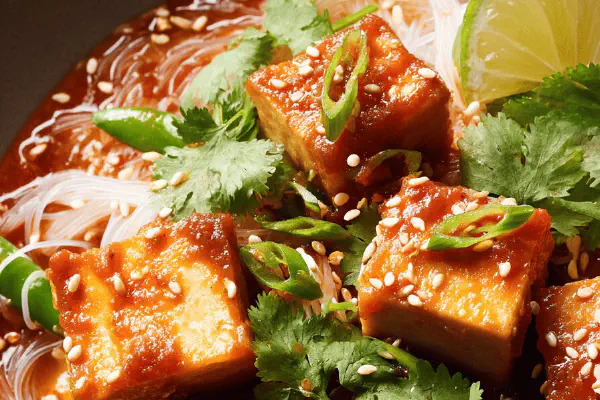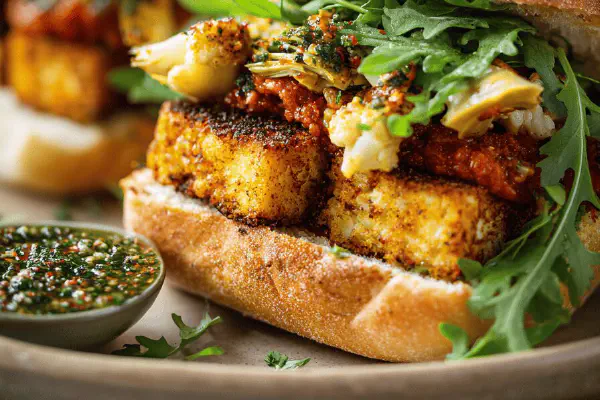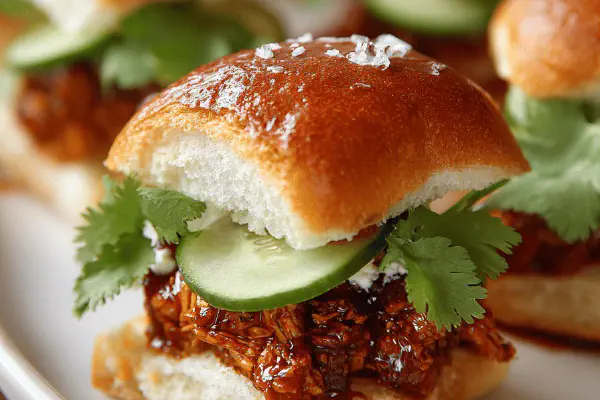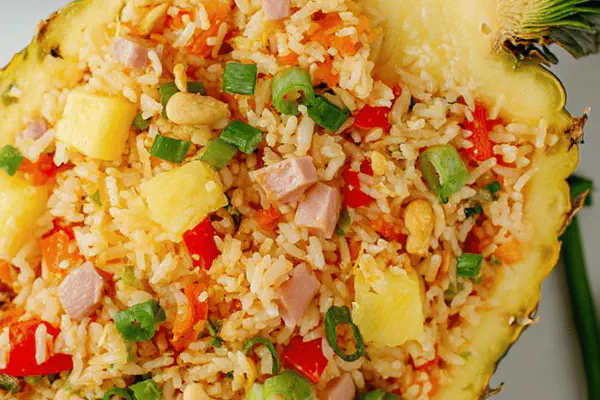Crispy Tofu Rice Bowls
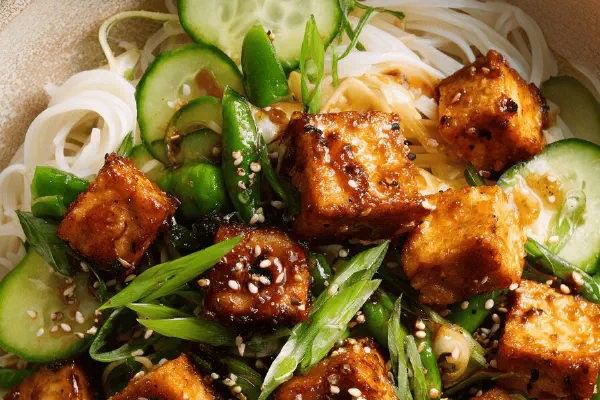
By Emma
Certified Culinary Professional
Ingredients
- 230 g snow peas trimmed, halved
- 140 g medium rice noodles
- 70 ml low sodium soy sauce
- 25 ml rice vinegar
- 15 ml maple syrup
- 15 ml Korean chili powder (gochugaru), or 5 ml sambal oelek
- 15 ml toasted sesame oil
- 6 Lebanese cucumbers, halved lengthwise and cut into 3 angled chunks
- 35 g cornstarch
- 460 g firm tofu, pressed and cut into large cubes
- 45 ml neutral vegetable oil
- 30 ml toasted sesame seeds
- 1 scallion, thinly sliced
About the ingredients
Method
- Bring salted water to a boil. Drop snow peas in; cook 3 minutes or until just tender but still bright green and crisp. Scoop out with tongs, plunge into ice water to halt cooking and keep crispness. Drain well, then halve snow peas for bite-size ease. Set aside.
- In same pot, cook rice noodles 3 to 4 minutes until al dente. Noodles should quiver but snap slightly when bitten. Drain quickly and rinse under cold water to stop cooking and remove excess starch. Drain again; keep aside.
- Whisk soy sauce, rice vinegar, maple syrup, chili powder, toasted sesame oil, and pepper in a large bowl until sugar dissolves. Add cucumbers and snow peas. Toss to coat thoroughly, let macerate while preparing tofu.
- Place cornstarch in another bowl. Roll tofu cubes in cornstarch until well coated, pressing gently so it sticks evenly for crisping.
- Heat vegetable oil in a large nonstick skillet over medium-high. Oil should shimmer but not smoke. Add tofu cubes, cook without disturbing for 2-3 minutes until golden then turn to brown all sides evenly, about 10 to 13 minutes total. Texture must be crispy outside, tender inside. Remove and drain on paper towels to lose excess oil.
- Add tofu to bowl with veggies and dressing. Gently fold, careful not to break tofu, so sauce clings well but tofu retains crisp edges.
- Divide noodles between bowls, top with dressed tofu and veggies. Sprinkle toasted sesame seeds and sliced scallions over the top for crunch and fresh oniony punch. Serve immediately before tofu sogginess begins.
Cooking tips
Chef's notes
- 💡 Cornstarch on tofu — small step, huge crunch difference. Press tofu firm, dry well. Roll cubes gently, don't overload cornstarch or it flakes off mid-fry. Oil must shimmer not smoke; temperature drop ruins crust. Hold off stirring too soon. Flip slowly, tofu fragile if rushed. Remove onto paper towel quick to lose oil. Texture contrast wins bowl here.
- 💡 Marinate cucumbers and snow peas in sauce while tofu cooks. Macerate just enough to soften edges, not limp. Toss gently, sauce needs to cling not drown veggies. Watch soy sauce saltiness closely. Big flavor punch from Korean chili powder or sambal, adjust spice level carefully — no one wants mouth scorch. Sesame oil toasted aroma opens senses, not same as plain oil.
- 💡 Rice noodles timing critical. Boil briefly, 3-4 minutes max. Al dente bite means firm snap, no mush. Rinse cold right away, stops starch from building sticky mess. Drain fully or watery noodles kill texture balance. Noodles should cool before plating, contrast warm tofu and crisp veggies. Skip soaking alone; boiling precise heat needed to avoid limpness.
- 💡 Frying tofu evenly takes patience; 10-13 minutes total turning all sides. Don’t overcrowd pan; oil temp falls, crust fails. Listen: gentle sizzle, not frantic popping. When golden brown, texture shifts from fragile to crisp; stop frying quickly or burn risk. Use neutral oil, extra virgin olive oil smokes early, flavor clash. Potato or tapioca starch swap fine, expect slightly different crunch feel.
- 💡 Assemble bowls last minute. Noodles cold, tofu still warm, veggies juicy but crisp. Toss tofu carefully with dressing to keep crust intact; clumsy folding breaks cubes, sauce seeps in weakening crunch. Toast sesame seeds dry pan few minutes — smell nutty, watch close. Scallions sliced thin for bite, contrast texture and flavor. Timing’s everything to keep bowl lively, never soggy.
Common questions
How best to press and prepare tofu?
Press with weight at least 30 mins. Pat dry very well. Freeze-thaw method tightens texture if no press handy. Cube size matters — large cubes hold crisp edges better. Rolling in cornstarch last step before frying avoids clumps. Moisture ruins crust, so dry surfaces.
Can I substitute snow peas with something else?
Sugar snap peas possible; similar crunch but sweeter note. Green beans blanched work too, firmer bite. Asparagus tips seasonal choice adds different texture, cook briefly same way for color bright and tender crisp. Avoid watery veggies that kill crisp contrast.
Why does tofu get soggy after frying?
Oil temp too low, tofu soaks oil, no crust. Don’t crowd pan, small batches keep temp steady. Flip gently only after golden set. Also, dressing tofu right away makes crust sweat, wait or fold lightly to keep crisp edges. Paper towel drain post fry mandatory to remove excess oil.
How to store leftovers?
Cool tofu and noodles separately, fridge in airtight containers. Veggies keep best fresh; dressing can be stored separately but veggies lose snap over time. Reheat tofu in dry skillet to bring back some crisp, avoid microwave sogginess. Noodles cold or room temp next day fine, toss with splash soy or oil to avoid sticking.
